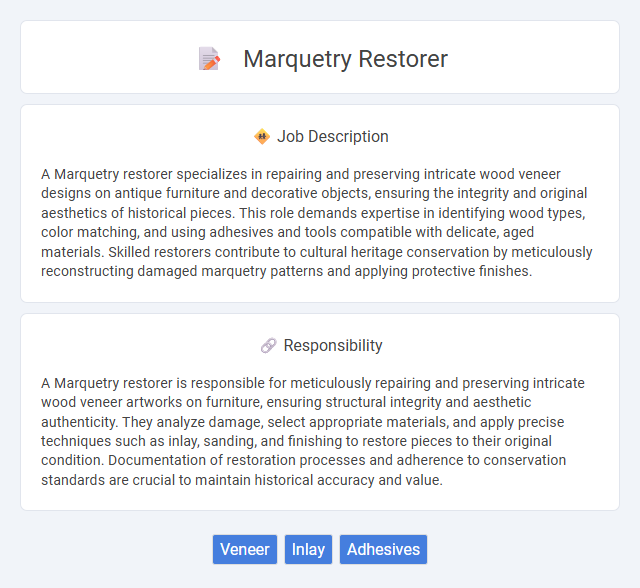
A Marquetry restorer specializes in repairing and preserving intricate wood veneer designs on antique furniture and decorative objects, ensuring the integrity and original aesthetics of historical pieces. This role demands expertise in identifying wood types, color matching, and using adhesives and tools compatible with delicate, aged materials. Skilled restorers contribute to cultural heritage conservation by meticulously reconstructing damaged marquetry patterns and applying protective finishes.
Individuals with patience, attention to detail, and steady hands are likely suitable for a marquetry restorer job, as the work demands precision and careful handling of delicate materials. Those who may struggle with fine motor skills or have difficulty concentrating for extended periods might find this role challenging. A passion for craftsmanship and historical preservation can increase the probability of job satisfaction and success in this field.
Qualification
A marquetry restorer must possess expertise in woodworking, fine arts, and conservation techniques to accurately repair and preserve intricate wood inlays. Proficiency in identifying various wood types, adhesives, and finishes is essential for effective restoration without compromising the artwork's integrity. Advanced skills in handcrafting, attention to detail, and knowledge of historical styles are crucial qualifications for maintaining authenticity in marquetry restoration projects.
Responsibility
A Marquetry restorer is responsible for meticulously repairing and preserving intricate wood veneer artworks on furniture, ensuring structural integrity and aesthetic authenticity. They analyze damage, select appropriate materials, and apply precise techniques such as inlay, sanding, and finishing to restore pieces to their original condition. Documentation of restoration processes and adherence to conservation standards are crucial to maintain historical accuracy and value.
Benefit
A Marquetry restorer likely enhances the value and longevity of intricate wood inlay pieces by carefully preserving their original beauty and craftsmanship. This role may provide opportunities to develop specialized skills in historical restoration techniques and contribute meaningfully to cultural heritage preservation. Working as a restorer could also foster a strong sense of accomplishment through the revival of delicate, artful designs that might otherwise deteriorate over time.
Challenge
Marquetry restorers likely face the challenge of precisely matching intricate wood veneers and patterns to preserve original designs while repairing damage. The probability of encountering delicate materials requires exceptional skill and a steady hand to avoid further harm. Complex historical pieces may present additional difficulty, demanding extensive knowledge of period-specific techniques and materials.
Career Advancement
Marquetry restorers specialize in preserving and repairing intricate wood veneer artworks, combining craftsmanship with art history knowledge. Career advancement often involves gaining expertise in various restoration techniques, developing a portfolio of successful projects, and building relationships with museums, galleries, and private collectors. Progression can lead to senior restorer roles, supervisory positions, or consultancy work within heritage conservation organizations.
Key Terms
Veneer
A Marquetry restorer specializes in the meticulous repair and preservation of decorative wood veneer surfaces, ensuring the intricate patterns and designs are accurately maintained. Expertise in matching wood species, grain patterns, and finishes is essential to restore damaged or missing sections seamlessly. This role demands precision, knowledge of traditional techniques, and the use of adhesives and tools specifically designed for veneer application and stabilization.
Inlay
Marquetry restorers specialize in repairing and preserving intricate inlay designs by expertly matching wood veneers and other materials to restore original patterns. They use precise cutting, gluing, and finishing techniques to seamlessly integrate replacement pieces into historic or damaged marquetry surfaces. Their work requires deep knowledge of wood types, inlay methods, and period-specific styles to maintain authenticity and value.
Adhesives
Marquetry restorers specialize in repairing intricate wood inlay artworks by selecting and applying adhesives that ensure both durability and minimal damage to original materials. They commonly use reversible adhesives such as fish glue or conservation-grade PVA to maintain the artwork's integrity during future restorations. Mastery of adhesive properties and presence of wood substrate is critical for successful fretwork realignment and veneer stabilization.
 kuljobs.com
kuljobs.com